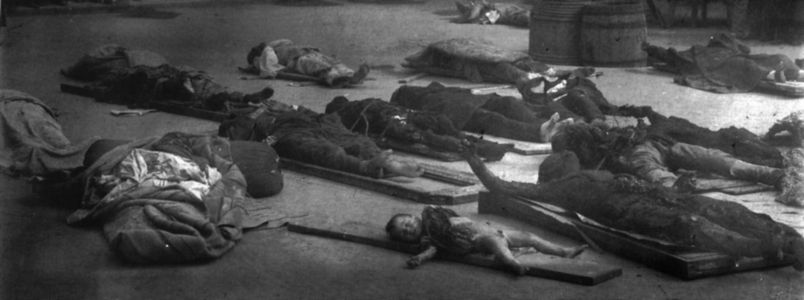Genocide of Azerbaijanis in Baku in March of 1918
On March 30, 1918 under the leadership of S.Shaumian Baku Soviet being under the authority of Lenin, Armenian party “Dashnaktsutiun” together with Armenian National Council began to slaughter Azerbaijani population. Noteworthy, their activities were aimed at inadmissibility of independence of Azerbaijan, the goal was to physically annihilate Azerbaijanis and include Azerbaijani lands into mythic “Great Armenia”. In February, 1918 Shaumian in the newspaper “Bakinski rabotchiy” directly declared: “Musavatists, wishing the autonomy, as a result of which would turn into a pile of ruins”. Furthermore, the “Red Army” consisted of 10-12 thousands soldiers (70 percent consisted of the Armenians), Armenians armed detachments, warships, military aircraft, armored vehicle, armored trains and artillery sent by Lenin were led by Shaumian. Armenian armories were located in the factories of millionaire Mantashev including other plants of influential Armenian oil industry businessmen as well as in cellars of Armenian church of Baku. Azerbaijani residents of Baku had no armed troops. On March 30, 1918 in all parts of Baku began disorganized mass meetings of Azerbaijanis. The participants of the meetings claimed to distribute the weapons among them or to disarm Armenians gang detachments. On the same day, all without exception, Muslim parts of the city were attacked by armed of many thousands of Bolshevik-Armenian military units, and the bombardment from the air, and the ships of the Caspian navy fired on targets. Despite of declared truce on March 31, the massacres of Muslim quarters of the city continued.
Armenian armed forces based on prearranged lists first attacked the houses of the wealthy and noble Azerbaijanis. Afterwards, the attacks had been particularly intense and had mass character. Armed attack against Muslim population of Baku caused serious damage to the city and it was launched spontaneously in many parts of the city, in central streets and outskirts which were inhabited mainly by Azerbaijani residents from the lower class of society. Among corpses were women, children, old men, that fact proves the intentions of Armenian-Bolsheviks forces to slaughter Azerbaijan residents of the city and during the massacre neither age nor sex was respected. Noteworthy that Armenians began to loot and robbed the possessions of the Azerbaijanis, afterwards collected things in previously prepared warehouses of Armenian millionaires and industrialists. Apart from deliberately burnt and damaged houses which belonged to muslims, there were buildings reflecting social and cultural as well as spiritual; center of Azerbaijani population such as-the building of Muslim Charity Society “Ismailiyye”, editorial office “Kaspi” and “Achiq soz” including the hotels “Dagestan”, “Iskanderiyye” and “Islamiyye”. Hotels and caravanserais at where were staying Muslims were burnt together with people there. As confirmed also by the evidences that organizational role of Baku Armenian National Soviet and the party “Dashnaktsutiun” in March massacre in Baku, they rendered support to the massacres against Azerbaijanis, the representatives of Armenian intellectuals and aristocracy with arms in their hands including many representatives of “Armenian common people (chern)” as they were named like that by the Armenian elite took part in the massacres as well. Noteworthy that Jewish, Russian, Polish, Georgians neighbors and others played an active role in saving lives and the possessions of the Muslims in many cases. The brutalities and massacre of Azerbaijanis continued for a week. Azerbaijan massacres were came to an end by the claim of the Russian officers who were earlier under the authority of Baku Soviet, they had witnessed in shock and horror the unimaginable human tragedy when were massacred Russian officers and soldiers of 36th Turkestan regiment, as well as Russian sailors of the Caspian Navy, threatening to open fire towards Armenians quarters of the city. Armenians detachments attacked other surroundings of Baku. The victims of ferocities of Armenian armed troops became villages of Muhammedi, Akhmedli, Balakhani, Binagadi, Bibi-Heybat Hokmeli, Zabrat, Sabunchi, Ramana, Khirdalan and etc. According to official data on the number of killed people within a week there were massacred over 12 thousands of people in Baku. It is difficult to precise the total death toll during March massacre as the corpses from the streets of the city, courtyards, and houses had been taken away by different groups of people. Many corpses of muslim during the slaughter and the days after were thrown into the burning houses, wells, and the sea. Baku Soviet under the leadership of Shaumian didn’t give permission to estimate the number of the victims precisely. Consul of Iran Muhammad Said-ol Vesare Maragei emphasized that “as a result of activity of the commission organized and headed by him there were collected from the streets and courtyards and buried over 5, 000 muslims”. This is another evidence providing that the total number of dead bodies estimated over 12 thousand of people.
